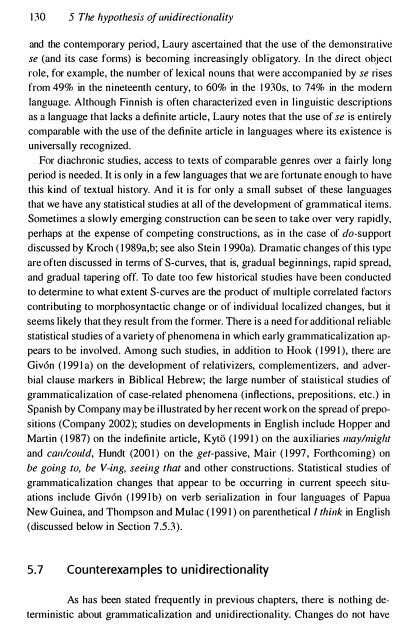Gram - SEAS
Gram - SEAS
Gram - SEAS
Create successful ePaper yourself
Turn your PDF publications into a flip-book with our unique Google optimized e-Paper software.
130 5 The hypothesis of unidirectionality<br />
and the contemporary period, Laury ascertained that the use of the demonstrative<br />
se (and its case forms) is becoming increasingly obligatory. In lhe direct object<br />
role, for example, the number of lexical nouns that were accompanied by se rises<br />
from 49% in the nineteenth century, to 60% in the I 930s, to 74% in the modern<br />
language. Although Finnish is often characterized even in linguistic descriptions<br />
as a language that lacks a definite article, Laury notes that the use of se is entirely<br />
comparable with the use of the definite article in languages where its existence is<br />
universally recognized.<br />
For diachronic studies, access to texts of comparable genres over a fa irly long<br />
period is needed. It is only in a few languages that we are fortunate enough to have<br />
this kind of textual history. And it is for only a small subset of these languages<br />
that we have any statistical studies at all of the development of grammatical items.<br />
Sometimes a slowly emerging construction can be seen to take over very rapidly,<br />
perhaps at the expense of competing constructions, as in the case of do-support<br />
discussed by Kroch (1989a,b; see also Stein I 990a). Dramatic changes of this type<br />
are often d ' iscussed in terms of S-curves, that is, gradual beginnings, rapid spread,<br />
and gradual tapering off. To date too few historical studies have been conducted<br />
to determine to what extent S-curves are the product of multiple correlated factors<br />
contributing to morphosyntactic change or of individual localized changes, but it<br />
seems likely that they result from the former. There is a need for additional reliable<br />
statistical studies of a variety of phenomena in which early grammaticalization appears<br />
to be involved. Among such studies, in addition to Hook (1991), there are<br />
Givon (1991 a) on the development of relativizers, complementizers, and adverbial<br />
clause markers in Biblical Hebrew; the large number of statistical studies of<br />
grammaticalization of case-related phenomena (inflections, prepositions. etc.) in<br />
Spanish by Company may be illustrated by her recent work on the spread of prepositions<br />
(Company 2002); studies on developments in English include Hopper and<br />
Martin (1987) on the indefinite article, Kyto (1991) on the auxiliaries may/might<br />
and call1cou/d, Hundt (200 I) on the get-passive, Mair (1997, Forthcoming) on<br />
be going to, be V-ing, seeing that and other constructions. Statistical studies of<br />
grammaticalization changes that appear to be occurring in current speech situations<br />
include Givon (199Ib) on verb serialization in four languages of Papua<br />
New Guinea, and Thompson and Mulac (1991) on parenthetical I thillk in English<br />
(discussed below in Section 7.5.3).<br />
5.7 Counterexamples to unidirectionality<br />
As has been stated frequently in previous chapters, there is nothing deterministic<br />
about grammaticalization and unidirectionality. Changes do not have
















